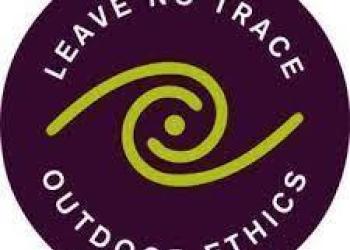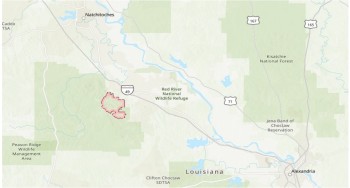Wilderness
The Kisatchie Hills Wilderness, located in central Louisiana, is home to some of the most steep and rugged terrain in the state. The 8,700 acres are covered with beautiful pine forests that provide habitat for a variety of wildlife, including multiple threatened and endangered species. The Kisatchie Hills Wilderness was designated by the United States Congress in 1980. It is one of only two federally designated Wilderness areas in the state and is the only one managed by the US Forest Service. The Kisatchie National Forest is also the only National Forest in Louisiana, making this Wilderness and the land it preserves even more unique.
The present-day Wilderness is on the traditional territory of the Caddo peoples and other Indigenous ancestral groups that many southeastern Tribes trace themselves to spanning back more than 12,000 years . The Caddo Confederacy consisted of a network of tribes who inhabited what is today Arkansas, Texas, and Louisiana. The name “Kisatchie” is possibly derived from the Kichai tribe, who referred to themselves as K’itsai , possibly Anglicized to Kisatchie. During the 18th century, European settlers began establishing settlements in the region. When the United States purchased the French Louisiana territory in 1803, the Caddo and other indigenous groups were further displaced from their land as more settlers moved into the region. The Wilderness falls in what was considered to be a broader “No Man’s Land” between the United States and colonial Spain. This neutral zone extended from Natchitoches Parish to the Sabine River. As such, it was a refuge for recently removed Tribes such as the Coushatta and Choctaw, runaway enslaved peoples, and many other groups. Remnants of old ”outlaw trails” are still visible today. In the late 1800s, the timber industry was booming in Louisiana and the present day Kisatchie Hills Wilderness was logged. In the 1910s, Louisiana was one of the leading states in the US for timber production. Logging and timber sales continue on the Forest today but ceased in Kisatchie Hills after Wilderness designation.
Location
Map showing Wilderness Area (highlighted in pink) in relation to nearby cities.
The Wilderness is located on the eastern edge of the Kisatchie National Forest and Kisatchie Ranger District. It is bordered by National Forest lands and private property. The surrounding area is relatively rural so the Wilderness remains free from the sights and sounds of human development beyond the boundary. The Kisatchie Hills Wilderness is located in Natchitoches Parish of Louisiana and falls between the cities of Alexandria and Natchitoches. It is also within a few hours’ drive of some larger metropolitan areas like Shreveport, New Orleans, and Houston. The proximity to these cities allows more people to access the Wilderness and experience the wild Louisiana backcountry.
Kisatchie Hills Wilderness Pine Ecosystem
The Kisatchie Hills Wilderness is blanketed in pine forests, which are primarily composed of longleaf (Pinus palustris) and loblolly pine (Pinus taeda). Longleaf pine forests are crucial ecosystems throughout the South. These forests consist of tall pine trees, a very thin and open understory, and wiregrass or shrubs that cover the ground. Due to modern human practices such as development, logging, and fire suppression, it is believed these forests inhabit less than 5% of their historic range. Kisatchie Hills Wilderness provides protection and preservation of this increasingly rare ecosystem. Many of the pine stands located in the Wilderness are second-growth forests that were planted after being logged throughout the late 19th and early 20th century. However, they still consist of native vegetation and provide important habitats for many plant and animal species. Throughout the Wilderness, there are also mixed hardwood forests, which are indicative of an ecosystem that has developed without periodic, low-intensity fires. The lack of fire has allowed other hardwood species like sweetgum (Liquidambar styraciflua) and willow oak (Quercus phellos) to thrive and compete with the pine trees.
The reduction in longleaf pine forests regionally has led to decreased suitable habitat for many animal species. The forests within the Kisatchie Hills Wilderness boundary continue to preserve these ecosystems for threatened and endangered species. The endangered red cockaded woodpecker (Leuconotopicus borealis), endangered northern long-eared bat (Myotis septentrionalis), and threatened Louisiana pinesnake (Pituophis ruthveni) all call the Wilderness home. Protecting the Wilderness in its natural condition, as stated in the Wilderness Act, will prevent further habitat loss in the region and allows an abundance of animal species to thrive.
Wilderness Remains Untrammeled and Undeveloped
According to the Wilderness Act of 1964, Wilderness is “recognized as an area where the earth and its community of life are untrammeled by [humans], where [humans themselves are] a visitor who does not remain.” The untrammeled quality is degraded by actions that intentionally manipulate the biophysical environment within the Wilderness area. Since designation, the Kisatchie Hills Wilderness has remained relatively untrammeled, allowing the ecological processes to proceed unencumbered.
Since designation, logging no longer occurs within the Wilderness boundary. Today, visitors can still see signs of historic logging and turpentine operations in the form of remnant stumps, old roadbeds, turpentine cups, and the ruins of an old turpentine mill.
Indigenous peoples of the Southeast would have stewarded places like the Kisatchie Wilderness through periodic low-intensity burning and other traditional land management practices. In the earlier days of the Kisatchie Hill Wilderness, there was very little fire management, so fires burned unsuppressed. In 1987 a high intensity wildfire burned 7,500 acres of the Wilderness in 10 days. In 2008, the Kisatchie National Forest began using regular prescribed burns within the Wilderness to return low-intensity fires to the landscape. Despite this effort, in 2010 the Wrangler Fire burned approximately 6,000 acres within the boundary. In 2012, prescribed burning to decrease fuel loads began again. Approximately 75% of the Wilderness was being burned on a three-year rotation. These prescribed burns ended in 2018. There are now fire management plans being written for future prescribed burns.
The Wilderness Act states that Wilderness areas should remain a place in which “the imprint of [human’s] work [is] substantially unnoticeable.” The Kisatchie Hills Wilderness has very little developments and protections offered by the Wilderness Act ensure it will remain this way. While it is nearly impossible for any land to be completely free of the developments and work of humans, the Kisatchie Hills Wilderness is relatively close.
Motorized vehicles are prohibited in Wilderness unless deemed necessary and authorized by the managing unit. In the past, motor vehicles and mechanical equipment have been used for fire management. A bulldozer was used previously to clear hazard trees after a fire, but this is no longer considered a standard practice. All-terrain vehicles are occasionally authorized to be used on trails and old roads during prescribed fires. Chainsaws are also used during prescribed burns and in the case of wildfire suppression. There are no inholdings or buildings within the boundary. Inholdings are parcels of privately owned property that are enclosed within the Wilderness boundary. The Wilderness abuts private property in some areas, but none of them overlap or fall within the Kisatchie Hills boundary. Due to the Wilderness designation, there will be no future inholdings or buildings here. This will prevent habitat loss or fragmentation and protect the feeling of remoteness, which preserves the undeveloped quality of wilderness character.
Hiking Trails in the Wilderness Area

There are three developed hiking trails that weave through the Kisatchie Hills Wilderness totaling 10 miles. Most visitors are found along these maintained corridors. Hiking and horseback riding are the most popular recreational activities within the Wilderness. The trails provide visitors with ample opportunity to experience the outdoors as they travel through the Kisatchie Hills. Hunting is also permitted within the Wilderness and provides a more primitive setting compared to the nearby Red Dirt Wildlife Preserve. Turkey, deer, and squirrel are popular game species.
Leave No Trace

Learn the 7 Principles of Leave No Trace to be a responsible visitor to the Wilderness. Each principle covers a specific topic and provides detailed information to empower you to minimize your impacts.






